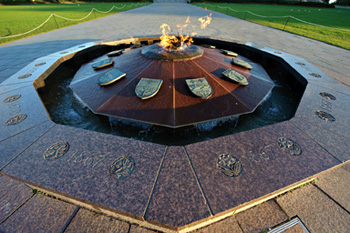Centennial Flame
On the evening of December 31, 1966, Lester B. Pearson launched Canada's 100th anniversary celebrations by lighting the Centennial Flame for the first time.
 Surrounded by the shields of the Canadian provinces and territories, and joined by the water of the fountain, the Centennial Flame symbolizes Canada's unity from sea to sea.
Surrounded by the shields of the Canadian provinces and territories, and joined by the water of the fountain, the Centennial Flame symbolizes Canada's unity from sea to sea.
The years inscribed on the border of the fountain, corresponding to the shield above, indicate when the province or territory joined Confederation. Starting at 1870, we have the shield of Manitoba. Moving clockwise, the order is Saskatchewan, 1905; Alberta, 1905; British Columbia, 1871; Yukon, 1898; Northwest Territories, 1870; Newfoundland, 1949; Prince Edward Island, 1873; Nova Scotia, 1867; New Brunswick, 1867; Quebec, 1867; Ontario, 1867.
Every day, visitors throw coins into the fountain. In 1991 the Centennial Flame Research Award Act was enacted to provide annual monetary awards to help disabled persons research and prepare a report regarding the participation of one or more disabled persons in Canadian public affairs or parliamentary activities. The award, funded through coins collected from the flame and donations to the Centennial Flame Research Award Fund, is presented yearly by the Standing Committee on Human Rights and the Status of Persons with Disabilities (HUMA).
Public Works and Government Services Canada is responsible for the operation and maintenance of this important national symbol. The Centennial Flame burns year-round other than when it is shut off for routine maintenance four times a year, when it can be off for up to a full day. In the winter, heat from the flame and the constant movement of the fountain's water ensures it does not freeze.
- Date modified: